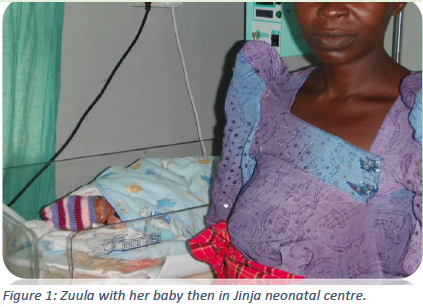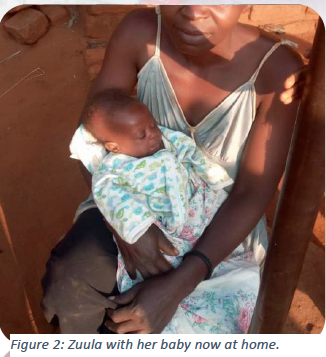- Vision for Africa Intl.
Jehova Rapha Clinic II Annual Clinical Performance Report 2019
Introduction:
Jehova-Rapha II (JR II) Health Clinic is a clinic located on the remote peninsula of Tongolo in Tongolo parish of Nyenga subdivision, Buikwe district. We minister under Vision for Africa International and we currently operate at a level of Health Centre III offering preventive, health promotive, outpatient curative, maternal and child health, inpatient health services and laboratory services. However, we also offer extra services like ultrasonography, ambulance and some possible minor operations. We treat, God heals.
Our Staff:
Jehova-Rapha II Clinic team is currently made up of 15 permanent staff members including 2 doctors, 3 nurses, 2 midwives, 1 laboratory personnel, 1 community health nurse, a clinic accountant, 2 askari, 2 house keepers, and 1 culinarian (cook).
General Performance:
14288 patients have visited our facility to receive health care services during this year. 9309 received Outpatient or Inpatient medical/surgical care (OPD/IPD), 3426 received Maternal and Child health care (MCH) while 1564 received Dental health care. There has been nearly a doubling of patient turn-up in 2019 compared to the year 2018 a doubling of patient turn-up in 2019 compared to the year 2018.

Patient Category:
Community 64%
Sponsored Students 20%
VfA Staff 6%
Staff Child / Spouse 5%
Non Sponsored Students 4%
Compassion 1%

Departmental Activities:
1. Out-Patient (OPD):
Out of the 9309 patients, 44.5% were Male and 55.5% were Female.
Malaria has remained the commonest health problem, contributing 3596 (38.6% of the total disease burden). It was followed by Gastritis (7.6%), Skin diseases (7.5%), Pneumonia (6.1%) and then Urinary Tract Infections (5%). We had 52 Measles cases this year but the burden has progressively reduced over the year to zero in the last month of 2019. All patients were managed successfully.
We referred 232 patients from the facility: 46 were referred with severe anaemia necessitating blood transfusion, 32 for non-obstetric surgery, 40 for HIV/AIDS care, 11 children for nutritional rehabilitation, and 40 people needed X-ray imaging. The other common reasons for referral included clinical chemistry, TB, CT scan and several forms of specialised care.
2. In-Patient:
We admitted and successfully managed 375 patients in our In-Patient Department.
3. Maternity and Child Health:
3426 people were attended to. 1311 Antenatal care (ANC) attendances - this has nearly tripled compared to the previous year. 334 successful birth deliveries.
We had 6 premature babies which were referred to a neonatal centre. 2 macerated still births. 7 mothers developed severe postpartum haemorrhage which was managed successfully, 1 of them was referred for blood transfusion. All other babies and mothers were discharged home in good health condition. We had no maternal deaths or new born deaths.
We referred 30 pregnant women for caesarean section and 4 with molar pregnancies.
We conducted 35 dilatation and curettage procedures for complicated abortions. 448 ladies received family planning methods from the facility. 1162 children were immunized at the facility.

4. Laboratory:
We investigated 8437 patients in our laboratory department. The commonest investigations done through the year was Malaria microscopy and rapid diagnostic tests (RDTs) (total 7617, with 3863 Positive). This was followed by Urinalysis (2433), Typhoid strip test (1026), H. pylori (700), pregnancy test (511), HIV test (553, 40 Positive and linked to care), Blood Sugar (507) and Complete blood count (439).
5. Radiology:
We performed 414 Ultrasound imaging investigations in this period, 251 were done on pregnant women.
6. Dental:
Together with Hope Smiles International -Jinja, we conducted 4 mega dental camps and we hosted a dentist bi-weekly. Through this service delivery we had 1554 patient visits: 1231 comprehensive exams and 261 review exams. Procedures done included 1538 extractions, 56 simple cleanings, 487 deep cleanings, 8 fluoride treatments, 354 silver diamine fluoride treatments, 84 composite fillings, 113 glass ionomer fillings, 35 zinc oxide eugenol fillings, 32 amalgam fillings, and 15 root canals.
7. Surgery:
We did 75 minor operations this year. These included 38 incision & drainage procedures, 7 herniorrhaphies, 10 surgical toilet & suturing, 3 safe male circumcisions, 2 thoracentesis, small mass excisions and biopsies, debridement, phimosis dilatation and suprapubic catheterisation. In the face of the complicated referral system. We improvise a mini-theatre with our treatment or maternity room. We referred 36 patients whose surgical conditions needed a high-level sterile theatre.
8. Outreaches:
We performed 25 community outreaches and visited 253 households for health education and health promotive services. During the outreaches, we immunized 1981 children including those involved in the national mass immunization program against measles, rubella and rota virus. We dewormed 470 school children, screened 48 pregnant ladies and offered family planning methods to 57 ladies.
9. CMEs:
We had 20 Continuous Medical education (CME) sessions for the clinic staff members.
10. Administration:
We still celebrate the fellowship and great team work and interdepartmental support exhibited by the technical and support staff of the clinic. We started the year with 11 team members, but now we are 15. Our smooth running has been greatly enforced by support from other departments in Vision for Africa for example Prayer Mountain for Leaders, Vocational School- Tongolo & Mt. Galilee Children’s Ministry. We are encouraged by the support from Vision for Africa Administration in Mukono.
Special Testimonies:
*** We have at least seen a bright light into our vision of extending hospital services to this desperate community: In that several people have donated unto the manifestation of this project. European friends donated €100,000 to support the construction and equipment of an Operating Theatre for Jehova-Rapha II Hospital. The Ministry of Health also pledged to donate 200 Million Uganda shillings for construction of a new Maternity building.
*** Our solar system was repaired and it currently sustains us 24/7 without any blackout.
*** We now have a flat TV screen in our facility – a great educational tool for patients in the queue.
***We have seen a great impact on our community: In the first half of 2019, three mothers died in our community as a result of attempting to deliver from home, by the time they came to us, we could only rush them to hospitals with operating theatres. But even in those hospitals, delays were inevitable. It took more than an hour to take even the ‘most’ dying mother to theatre because oxygen, blood or operation supplies were unavailable in the hospital. So the poor ones lost their lives, leaving behind desperate orphans. Two of these mothers came from the neighbouring village of Nangulwe. Several of other home-delivered new born babies also died. Through intense outreach and home-visit programs packed with health education and antenatal sensitisation and screening, we are slowly disarming the plague of maternal deaths and new born deaths.
In the second half of the year, no mother has died in our community as a result of home delivery. Increasingly more women have come to deliver from our clinic, and God has not disappointed them: They have walked out of our Clinic smiling, carrying bouncing babies and feeling loved. Even those that needed referral received it with enough time to face the complexities and delays in referral system. However, home deliveries are still ongoing in our community. In the last half of 2019, we have got many maternal near-misses, and 4 known home-delivered babies have died as a result of excessive bleeding or severe infection.
Mutonyi a 19 year old lady delivered her second born baby from home under assistance of her mother at 3 am, and the placenta was retained. She bled excessively and by the time they brought her to us was 6 am December 20, she was unconscious, in Class IV haemorrhagic shock with unrecordable blood pressure and still bleeding. We resuscitated her with 3 litres of normal saline through 2 large bore cannulae and we did manual removal of the retained placenta. We controlled the bleeding and she slowly recovered until discharge. Luckily, her baby was well.
We thank God for her life.
Our vision is ZERO HOME DELIVERY, but we thank God so far.
*** We are grateful for the friends who donated the funds to revive our Community Health program.
*** Some people needed taking by hand:
A poor lady called Zuula, mother of 5, married to a witch doctor, once delivered a 1 kg premature baby at only 28 weeks of gestation at our facility. The husband wanted to take the baby home having lost hope that this baby would never survive. When we insisted on referring the child to a neonatal centre, husband was very bitter and he dumped the mother and the baby to us. We facilitated Zuula and followed her up even in the hospital we had referred this baby. Glory to God, Zuula’s baby is still alive today! Now 6 months old, weighing 3.5 kg and strong.
*** The dental health services delivered through partnership with Hope Smiles International have blessed our community. We are thankful for donations from Europe which support this work
Challenges:
With the increasing pressure from patient turn-up, we have realised a need for increasing our human resource capacity. We are still unable to offer life-saving emergency surgeries and blood transfusion services which in the face of the delays at home and the complicated referral system has led to loss of lives. We lack HIV care and TB treatment services. We are also limited by space especially in the maternity department. We struggle with disposal of medical sharp waste which needs incineration. Our staff quarters are at full capacity; still some team members sleep outside the clinic staff quarters. We also lack the following vital equipment:
> Back-up QBC Microscope. The current one has got several repairs, and when it is down, we get stuck.
> Haemoglobinometer to back up the narrow-range CBC machine, as we look forward for a better one.
> Ceiling focus lamp for Procedure room
> Doppler Fetoscope for our Maternity department.
> Battery for our automated delivery bed (the current one is expired and no longer holds charge.)
> X-ray Machine
> We still struggle with telecommunication services at the clinic because there’s no network, and our WiFi network has been down for long.
Recommendations:
With great hope, we are looking forward to the establishment of Jehova-Rapha II Community Hospital with Operating Theatre (Surgery), Maternity Building and Staff Quarters. This will solve most of the service delivery limitations, space and accommodation challenges.
We are also looking forward to a boost in human resource capacity to meet the patient demands. We shall do this gradually over this New Year.
The following should also be put into immediate consideration:
> Construction of an Incinerator.
> Securing these much required equipment, that is, back-up QBC Microscope, haemoglobinometer, Advanced CBC Machine, Ceiling focus lamp, Doppler Fetoscope, Battery for our automated delivery bed and X-ray machine.
> Establishment of blood transfusion services.
> Establishment of HIV/AIDS care and TB treatment services
> Improvement of telecommunication services and WiFi network.
Any support towards this goal will be highly valued!




